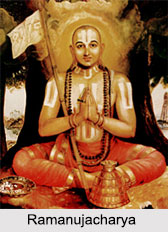 Alvar means one who is `immersed` in the experience of God. They came from all walks of life and all strata of society and include in their ranks one lady, namely Andal. They believed in the worship of lord Vishnu.
Alvar means one who is `immersed` in the experience of God. They came from all walks of life and all strata of society and include in their ranks one lady, namely Andal. They believed in the worship of lord Vishnu.
According to historians the Alvars, flourished between the 6th and 9th centuries A.D. and their hymns in Tamil, collectively called the Nalayim Divya Prabandham (the four thousand divine hymns) enjoyed an exalted place in the devotional literature of India. The first three Alvars, called the Mudal Alvars are Poigai Alvar, Bhudat Alvar and Pey Alvar, born in Kanchipuram, Mamallapuram (Mahabalipuram) and Mylapore (Chennai) travelled to various places singing the glory of Vishnu. Once all three met together in Tamil Nadu where they realized the presence of God and they composed a hundred verses each known as the first, second and third Anthadis.
Tirumazhisai Alvar hailed from the village of Tirumazhisai (near Chennai). He studied Buddhism, Jainism and Saivism and ultimately felt that Siva was the Supreme Being. He composed the Nanmukhan Tiruvandadi and Tirucchanda Viruttam. Nammalvar is the most venerated of all the Alvars whom the Sri Vaishnavas worship. His famous work Tiruvaymozhi is considered the Tamil Veda. Nammalvar, also known as Sadagopa (Shatakopa) was from Tirukurugur (near Tirunelveli). Even as a child, he was lost in deep meditation and love for Vishnu and had no interest in worldly life.
Every Vaishnava temple in the Tamil land has a sculpture of this great saint. His contemporary and disciple was Madhurakavi Alvar who was born in Tirukolur, and who sang of none other than his master Nammalvar. Kulasekhara Alvar was a king of Kerala who was well versed in both Sanskrit and Tamil and was also a great devotee of Narayana. Later he handed over the kingdom to his son and decided to devote himself to the service of the Lord. He went to the Ranganatha Svami temple in Srirangam and later to Tirupati, Kanchipuram and other venerated Vaishnava centres. He composed the Perumal Tirumozhi and the famous Sanskrit poem Mukundamala has been credited to him.
Perialvar or Vishnuchitta belonged to Srivilliputtur in the Pandyan country. He learnt the scriptures and decided to devote his life to serving the Lord. Maintaining a garden, he used to make garlands with Tulasi leaves and adorn the God in the Srivilliputtur temple everyday. Although learned, he was not trained properly under a teacher, but with the Lord`s guidance, entered into a debate on spiritual matters with scholars and emerged victorious.
Andal, the foster daughter of Perialvar, is well known as the composer of the immortal works Tiruppavai and Nachiyar Tirumozhi. She was a great devotee of Krishna and wanted to marry none but Lord Vishnu. Tondaradippodi Alvar was also known as Vipranarayana. He was a cultured person who was very attached to Lord Ranganatha of Srirangam and spent most of his time tending a garden near the temple from which he collected flowers to make garlands for the deity. His works are the Tirupalliyezhuchi, which is recited in most Vishnu temples early in the morning for waking up the Lord and Tirumalai, which is a wonderful garland of verses.
Tiruppan Alvar was a saint who belonged to a family oipanars or bards engaged in singing with the stringed instrument called yazh. Tiruppanalvar was totally immersed in devotion to Lord Ranganatha of Srirangam and spent all his time singing his praise. He too merged with this deity at Srirangam. His famous work is the Amalanadapiran. He was also known as Munivahana and as Kavishwarar.
One of the most famous Alvars is Tirumangai Alvar also known as Parakalan. He visited many Vishnu shrines across the length and breadth of India and sang numerous hymns in praise of the deities in the temples situated therein. The collection of hymns comprises the Periya Tirumozbi and they are soaked in bhakti or devotion. He was, like Nammalvar, a master of the spiritual art of divine love.









